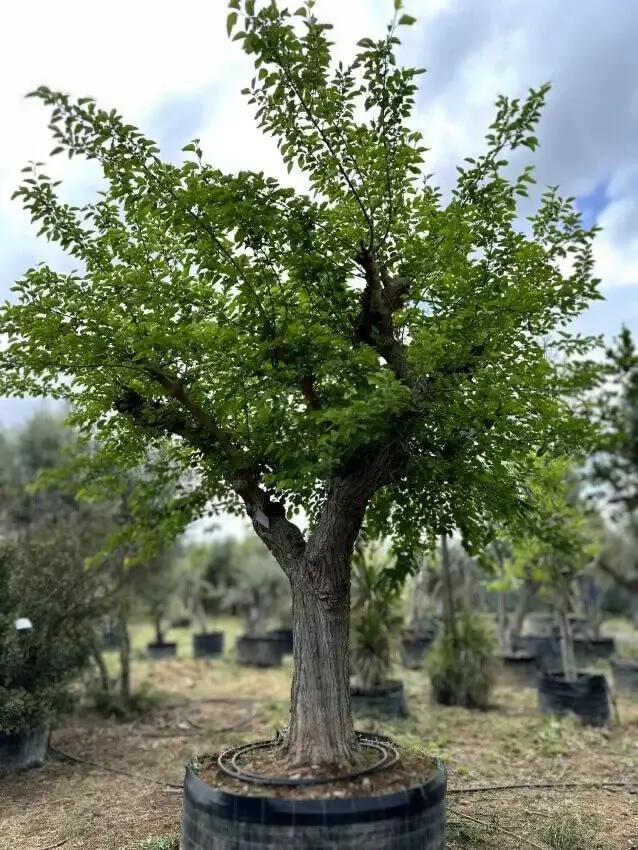The mulberry is one of the most popular deciduous trees in the Greek landscape because of the wonderful shade provided by its foliage. It belongs to the family Moracae and the genus Morus (of the Moridae). Since its introduction to Greece in ancient times, it has been known by the names Sycaminia, Xinomouria and Mournia. It is a fast-growing tree, which can reach a height of more than 15 metres and can be found in streets, courtyards, parks, in the city and of course in villages. And the ornamental mulberry is one of the leading shade trees in landscape architecture, since with proper shaping of its branches it can create a natural pergola. In addition to being an ornamental tree, the mulberry often bears delicious and healthy fruits, which are considered superfood. Still, its trunk is an excellent wood in furniture making and its leaves, as they are ideal food for silkworms.
Varieties of mulberry
It is found in varieties that bear fruit and others that do not, such as the ornamental plane-leaved mulberry tree. This type of mulberry does not bear fruit, while its leaves resemble those of the plane tree, hence its name. It is a less expansive tree than the fruit-bearing mulberries and is often a little shorter in height. In other words, it is the most suitable for places where cleanliness is of major importance, such as hotels, garages and pavements.
The most widespread fruiting mulberries in the Mediterranean are the black and white mulberry. The black or common mulberry (Morus nigra) is native to the Caspian Sea regions and reaches a height of up to 8 m (the shortest). It has dark green leaves with a wide, fluffy undersurface. The berries it produces are naturally dark in colour and are the most palatable, as they have a sweet taste. Their maturing period is from July to August, when they take on a very dark red colour.
On the other hand, the white mulberry (Morus alba) originates from China and grows up to 15 metres. Its foliage is more elongated and glossier, with a light green colour. The fruits have a striking white colour, which can sometimes turn slightly red. The fruits of the white mulberry are sourer and therefore not so much used for eating, but they are excellent food for silkworms, as the leaves of the black mulberry made the silk coarser.

Soil and climatic conditions
The mulberry tree stands out among Mediterranean trees, not only because of its beauty, but also because of its excellent resistance to adverse conditions. It grows successfully in dry soils and can withstand high levels of salinity. If, of course, it is found in fertile soils, with high organic matter and good drainage, the results are impressive. Although mulberry loves the sun, it can withstand low temperatures and snow. Finally, it is no coincidence that it is widely used in urban landscapes since it is one of the trees with the highest resistance to atmospheric pollution.
Watering
The mulberry tree is quite resistant to drought. Of course, watering during the summer months, but also during the period of fruit growth and production, should not be omitted so that the foliage is lush and the fruit is plentiful and juicy. However, it is important to avoid over-irrigation, as this can lead to excess soil moisture and root problems. Thus, it is good to monitor weather and soil moisture before watering to adjust the frequency and amount of water according to the tree’s needs.
Fertilization
Another factor that contributes to the growth of the tree is fertilization. Fertilizers with a higher nitrogen content in late winter, when the very cold weather will have ended, lead to more vibrant foliage, while those with a corresponding potassium content lead to more fruit bearing. Remember to apply fertilizers according to the instructions and avoid over-application, as this can lead to problems of soil nutrition or pollution. At the same time, provide a sufficient amount of water after fertilization to ensure that the tree’s roots absorb the nutrients effectively.
Propagation
– Propagation by seed is done in the spring in a seedbed, followed a year later by transplanting to the nursery. Importantly, however, it does not allow the establishment of trees with the same characteristics as the parent tree and thus only serves to produce young subjects for propagation.
– Eye inoculation or grafting takes place again in spring at the base of large trees or on young seedlings from seed. Stigmas of 4-5 cm in length are used, taken from a small branch of the desired variety. The grafted young trees are planted the following year in their final position.
– Finally, cuttings are a very good way of propagation for mulberry trees, with the exception of certain ornamental varieties which are propagated only by seed. Cuttings of mature wood up to 30 cm long are planted in spring, at a relatively great depth so that only 2-3 ‘eyes’ protrude from the ground. After about two years, when they have achieved satisfactory growth, they are transplanted directly to their final location.
Diseases
As far as diseases are concerned, mulberry trees are very resistant to fungi and insects. However, its biggest enemy is the honeydew or aphids. In recent years, infestations of the wood-eating insect Xylotrechus chinensis have occurred. The larvae of this insect enter the trunk and open galleries, leading to problems in the transport of water and nutrients.
Bonus tip
And a bonus tip for those who made it this far! Berries have vitamin C, K, potassium, calcium, phosphorus and iron, and are highly anti-cancer and tumor-fighting, according to research. At the same time, they increase good cholesterol (HDL) and help reduce weight (73% increase in lipolysis capacity), control diabetes, and prevent Parkinson’s and Alzheimer’s disease. So, let’s add berries to our diet!

